Numerical Study on Pile Group Effect and Carrying Capacity of Four-Barreled Suction Pile Foundation under V-H-M Combined Loading Conditions
Abstract
:1. Introduction
2. FE Numerical Model
2.1. Model Construction and Material Properties
2.2. Validation of the Numerical Model
3. Loading Carrying Capacity of the Foundation
3.1. Determination of Loading Carrying Capacity
3.2. Definition of Load and Displacement
4. Pile Group Effect
4.1. Under Vertical Loading Condition
4.2. Under Horizontal Loading Condition
4.3. Under Moment Loading Condition
4.4. Under Torsional Loading Condition
4.5. Effect of Non-Homogeneity of Clay on Group Efficiency
5. Carrying Capacity Envelope under Combined Loading Conditions
5.1. Combined H-M Capacity Envelope
5.2. Combined V-H-M Capacity Envelope
6. Conclusions
- (1)
- At S/D ratios ≤ 2, the EV varies from 0.96 to 1. At an S/D ratio ≥ 2, the EV is 1. The bending capacity can be obtained by multiplying the moment dimensionless load NM(S) of the single-barreled suction pile foundation with the pile group effect coefficient EM. The torsional carrying capacity can be calculated by multiplying the horizontal carrying capacity of the single-barreled suction pile foundation with a fixed rotational degree of freedom by the torque length.
- (2)
- The non-homogeneity of clay has little effect on the pile group effect coefficient of the carrying capacity of four-barreled suction pile foundations.
- (3)
- Under the combined action of horizontal and bending moment loads, the foundation carrying capacity envelope of the H-M load space shows obvious asymmetry. With the increase in S/D ratios, the bending moment carrying capacity increases proportionally. Due to the weakening of the pile group effect, the horizontal carrying capacity finally reaches a constant value at S/D = 2–3. Appropriate pile spacing should be selected to weaken the pile group effect in practical engineering design.
- (4)
- The size of the failure envelope of the foundation carrying capacity under the H-M load space of the four-barreled suction pile foundation decreases with the increase in the vertical load. When the vertical load increases from V = 0 to 0.75 Vult, the bending moment carrying capacity can be reduced by 59%. Considering the large weights of subsea oil platforms, it is necessary to pay attention to the vertical load in their design and construction.
Author Contributions
Funding
Institutional Review Board Statement
Informed Consent Statement
Data Availability Statement
Conflicts of Interest
References
- Achmus, M.; Kuo, Y.S.; Abdel-Rahman, K. Behavior of monopile foundations under cyclic lateral load. Comput. Geotech. 2009, 36, 725–735. [Google Scholar] [CrossRef]
- Houlsby, G.T.; Wroth, C.P. Calculation of Stresses on Shallow Penetrometers and Footings. In Seabed Mechanics; Springer: Berlin/Heidelberg, Germany, 1984; pp. 107–112. [Google Scholar]
- Butterfîeld, R.; Houlsby, G.T.; Gottardi, G. Standardized sign conventions and notation for generally loaded foundations. Geotechnique 1997, 47, 1051–1054. [Google Scholar] [CrossRef]
- Hu, Y.; Randolph, M.F.; Watson, P.G. Bearing response of skirted foundation on nonhomogeneous soil. J. Geotech. Geoenviron. Eng. 1999, 125, 924–935. [Google Scholar] [CrossRef]
- Wang, H.; Cheng, X. Undrained bearing capacity of suction caissons for offshore wind turbine foundations by numerical limit analysis. Mar. Geores. Geotechnol. 2015, 34, 252–264. [Google Scholar] [CrossRef]
- Houlsby, G.T.; Kelly, R.B. Field trials of suction caissons in clay for offshore wind turbine foundations. Geotechnique 2005, 55, 287–296. [Google Scholar] [CrossRef]
- Chen, W.; Randolph, M.F. Uplift capacity of suction caissons under sustained and cyclic loading in soft clay. J. Geotech. Geoenviron. Eng. 2007, 133, 1352–1363. [Google Scholar] [CrossRef]
- Yadav, S.K.; Ye, G.L.; Khalid, U.; Fukuda, M. Numerical and centrifugal physical modelling on soft clay improved with floating and fixed sand compaction piles. Comput. Geotech. 2019, 115, 103160. [Google Scholar] [CrossRef]
- Kim, S.R. Evaluation of vertical and horizontal bearing capacities of bucket foundations in clay. Ocean Eng. 2012, 52, 75–82. [Google Scholar]
- Vulpe, C. Design method for the undrained capacity of skirted circular foundations under combined loading: Effect of deformable soil plug. Geotechnique 2015, 65, 669–683. [Google Scholar] [CrossRef]
- Yadav, S.K.; Ye, G.L.; Xiong, Y.L.; Khalid, U. Unified numerical study of shallow foundation on structured soft clay under unconsolidated and consolidated-undrained loadings. Mar. Geores. Geotechnol. 2020, 38, 400–416. [Google Scholar] [CrossRef]
- Tanoli, A.Y.; Yan, B.; Xiong, Y.L.; Ye, G.L.; Khalid, U.; Xu, Z.H. Numerical analysis on zone-divided deep excavation in soft clays using a new small strain elasto—Plastic constitutive model. Undergr. Space 2022, 7, 19–36. [Google Scholar] [CrossRef]
- Gourvenec, S.; Jensen, K. Effect of embedment and spacing of cojoined skirted foundation systems on undrained limit states under general loading. Int. J. Geomech. 2009, 9, 267–279. [Google Scholar] [CrossRef]
- Kim, S.R.; Hung, L.C.; Oh, M. Group effect on bearing capacities of tripod bucket foundations in undrained clay. Ocean Eng. 2014, 79, 1–9. [Google Scholar] [CrossRef]
- Zhang, L.M.; Kong, L.G. Centrifuge modeling of torsional response of piles in sand. Can. Geotech. J. 2006, 43, 500–515. [Google Scholar] [CrossRef]
- Gourvenec, S.M.; Mana, D.S.K. Undrained vertical bearing capacity factors for shallow foundations. Geotechnique 2011, 1, 101–108. [Google Scholar] [CrossRef]
- Andersen, K.H.; Dyvik, R.; Schrøder, K.; Hansteen, O.E.; Bysveen, S. Field tests of anchors in clay II: Predictions and interpretation. J. Geotech. Eng. ASCE 1993, 119, 1532–1549. [Google Scholar] [CrossRef]
- Zhu, B.; Dai, J.L.; Kong, D.Q.; Feng, L.Y.; Chen, Y.M. Centrifuge modelling of uplift response of suction caisson groups in soft clay. Can. Geotech. J. 2020, 57, 1294–1303. [Google Scholar] [CrossRef]
- Stergiou, T.; Terzis, D.; Georgiadis, K. Undrained bearing capacity of tripod skirted foundations under eccentric loading. Geotechnik 2015, 38, 17–27. [Google Scholar] [CrossRef]
- Yun, G.; Bransby, M.F. The undrained vertical bearing capacity of skirted foundations. Soils Found. 2007, 47, 493–505. [Google Scholar] [CrossRef] [Green Version]
- Lai, Y.; Chen, C.; Zhu, B.; Dai, J.L.; Kong, D.Q. Numerical modelling on effect of loading rate on uplift behavior of suction caissons. Ocean Eng. 2022, 260, 112013. [Google Scholar] [CrossRef]
- Bhowmik, D.; Baidya, D.K.; Dasgupta, S.P. A numerical and experimental study of hollow steel pile in layered soil subjected to lateral dynamic loading. Soil Dyn. Earthq. Eng. 2013, 53, 119–129. [Google Scholar] [CrossRef]
- Sinha, A.; Hanna, A.M. 3D numerical model for piled raft foundation. Int. J. Geomech. 2017, 17, 04016055. [Google Scholar] [CrossRef]
- Achmus, M.; Akdag, C.T.; Thieken, K. Load-bearing behavior of suction bucket foundations in sand. Appl. Ocean Res. 2013, 43, 157–165. [Google Scholar] [CrossRef]
- Taiebat, H.A.; Carter, J.P. Numerical studies of the bearing capacity of shallow foundations on cohesive soil subjected to combined loading. Geotechnique 2000, 50, 409–418. [Google Scholar] [CrossRef] [Green Version]
- Houlsby, G.T.; Martin, C.M. Undrained bearing capacity factors for conical footings on clay. Geotechnique 2003, 53, 513–520. [Google Scholar] [CrossRef]
- Martin, C.M.; Hazell, E.C.J. Bearing Capacity of Parallel Strip Footings on Non-Homogeneous Clay. In Proceedings of the International Symposium on Frontiers in Offshore Geotechnics, Perth, Australia, 19–21 September 2005; pp. 427–433. [Google Scholar]
- Gourvenec, S.; Steinepreis, M. Undrained limit states of shallow foundations acting in consort. Int. J. Geomech. 2007, 7, 194–205. [Google Scholar] [CrossRef]
- Xiao, Z.; Tian, Y.; Gourvenec, S. A practical method to evaluate failure envelopes of shallow foundations considering soil strain softening and rate effects. Appl. Ocean Res. 2016, 59, 395–407. [Google Scholar] [CrossRef] [Green Version]
- Fan, Q.L.; Luan, M.T. Elasto-Plastic FEM Analyses of Large-Diameter Cylindrical Structure in Soft Ground Subjected to Wave Cyclic Loading. Slope Stability, Retaining Walls, and Foundations. In Proceedings of the 2009 GeoHunan International Conference, Changsha, China, 3–6 August 2009. [Google Scholar]
- Bransby, F.; Randolph, M. The effect of embedment depth on the undrained response of skirted foundations to combined loading. Soils Found. 1999, 39, 19–33. [Google Scholar] [CrossRef] [Green Version]
- Bandyopadhyay, S.; Sengupta, A.; Parulekar, Y.M. Behavior of a combined piled raft foundation in a multi-layered soil subjected to vertical loading. Geomech. Eng. 2020, 21, 379–390. [Google Scholar]
- Mansur, C.I.; Kaufman, R.I. Pile Tests, Low-Sill Structures, Old River, Louisiana. J. Soil Mech. Found. Div. 1956, 82, 1079. [Google Scholar] [CrossRef]
- Supachawarote, C.; Randolph, M.; Gourvenec, S. Inclined Pull-Out Capacity of Suction Caissons. In Proceedings of the Fourteenth International Offshore and Polar Engineering Conference, Toulon, France, 23–28 May 2004. [Google Scholar]
- Gourvenec, S. Effect of embedment on the undrained capacity of shallow foundations under general loading. Geotechnique 2008, 58, 177–185. [Google Scholar] [CrossRef]
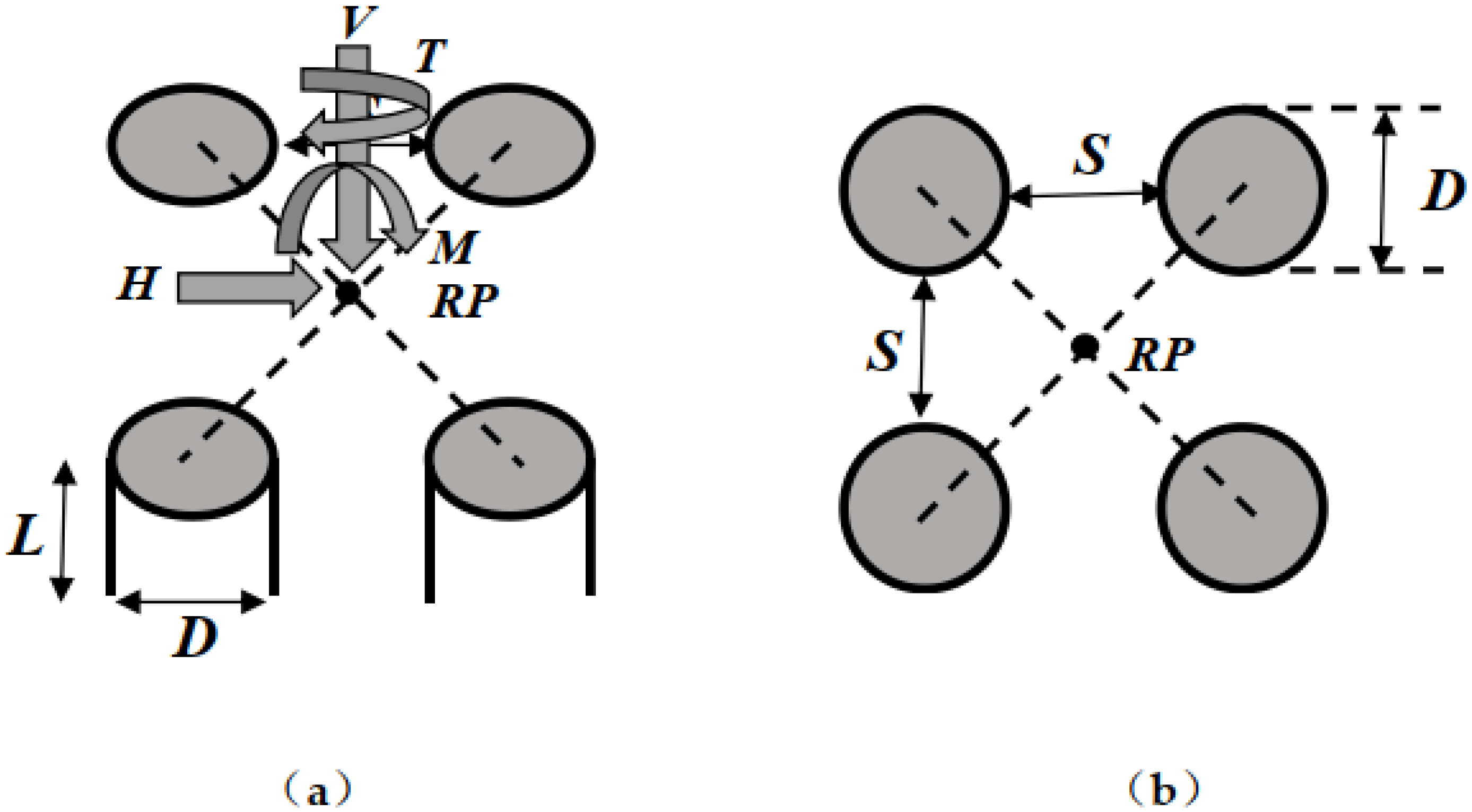
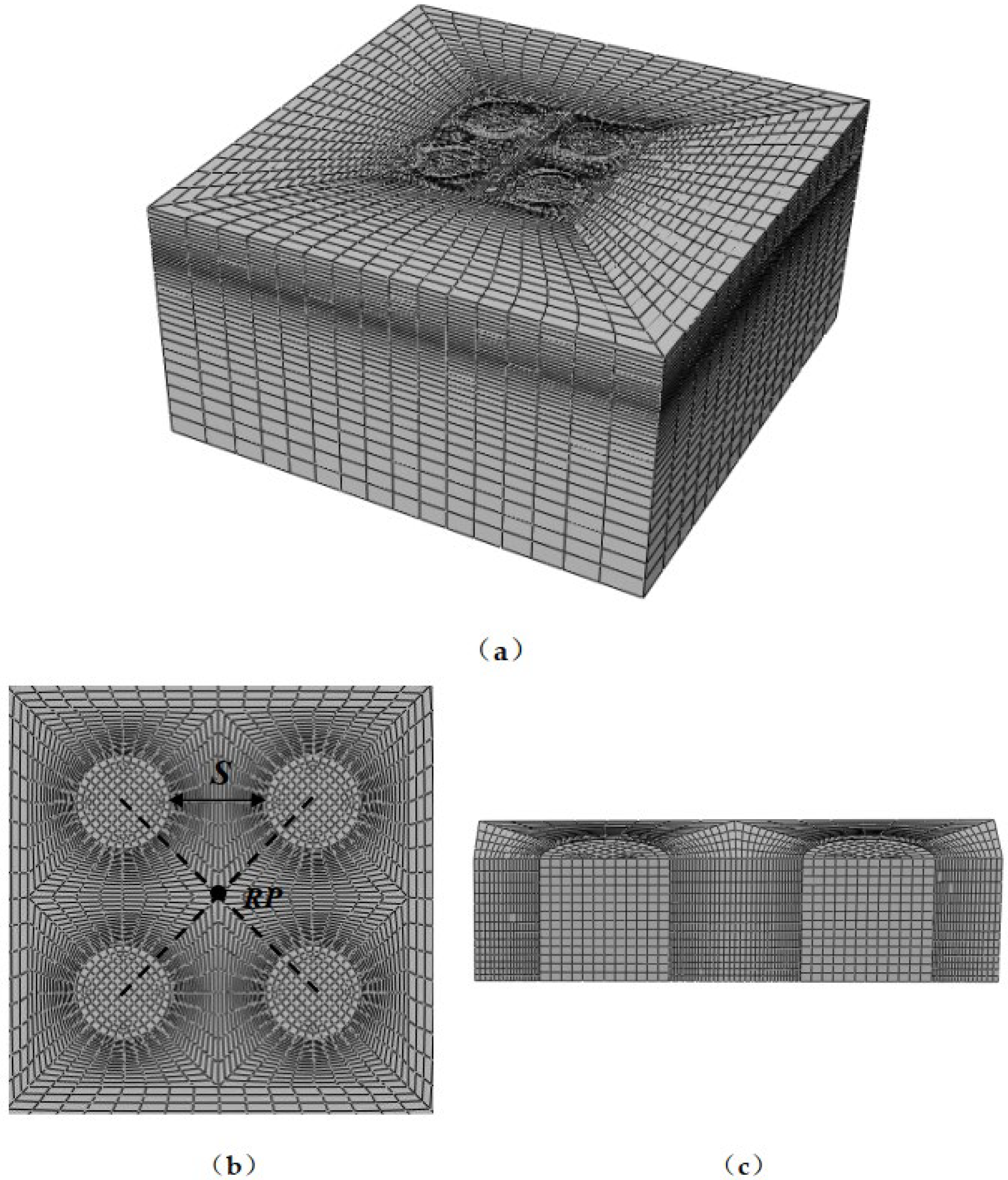
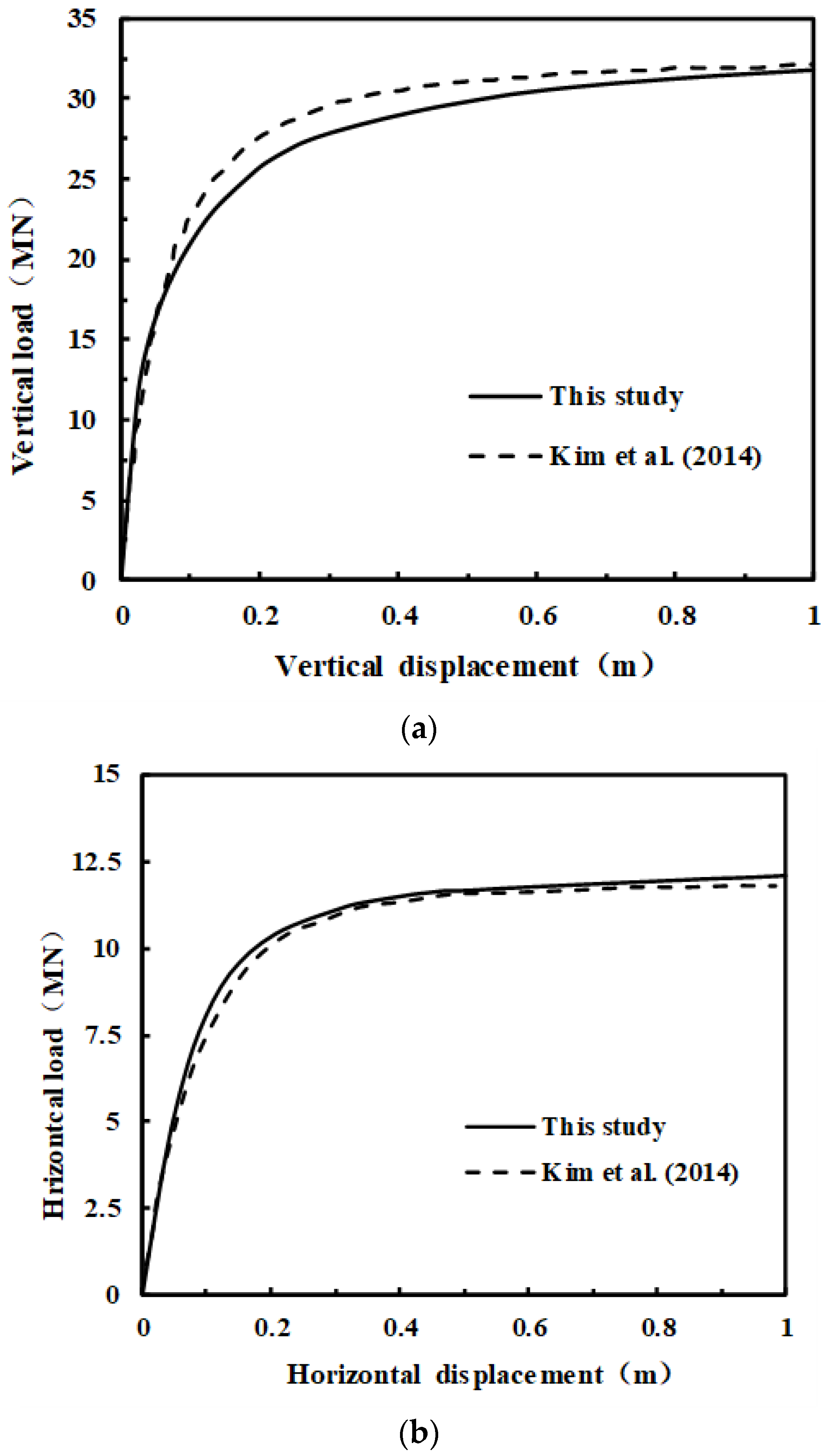

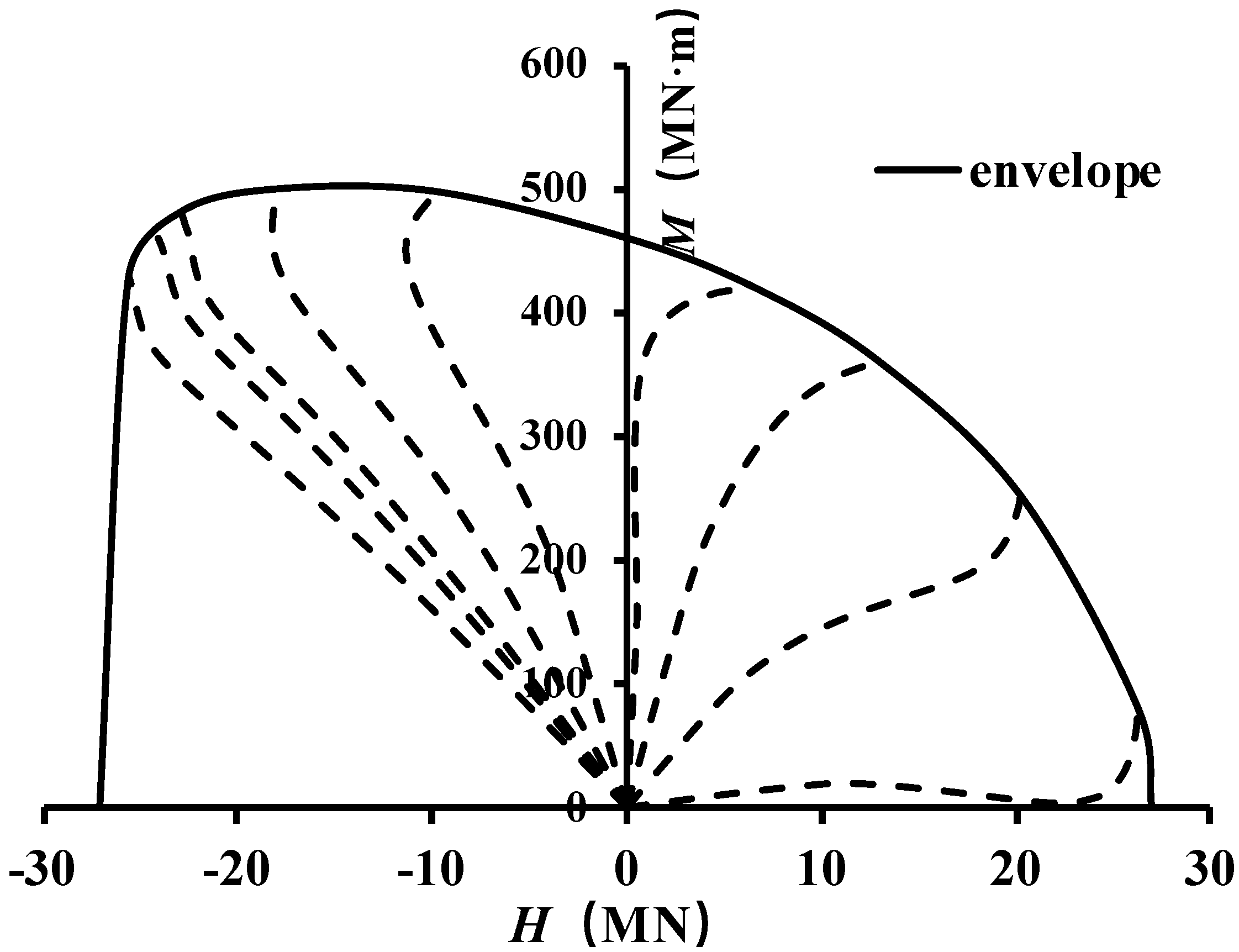

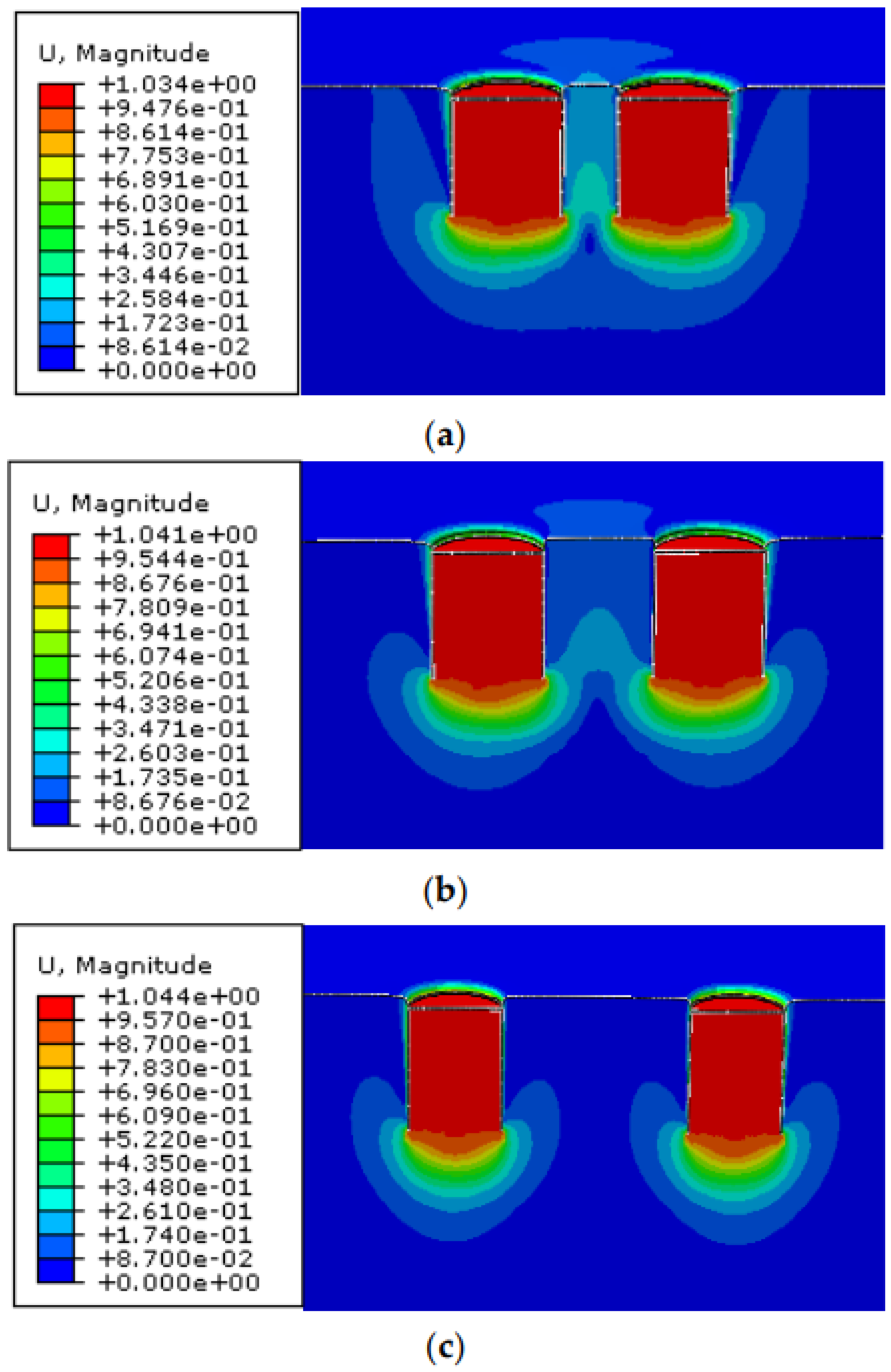
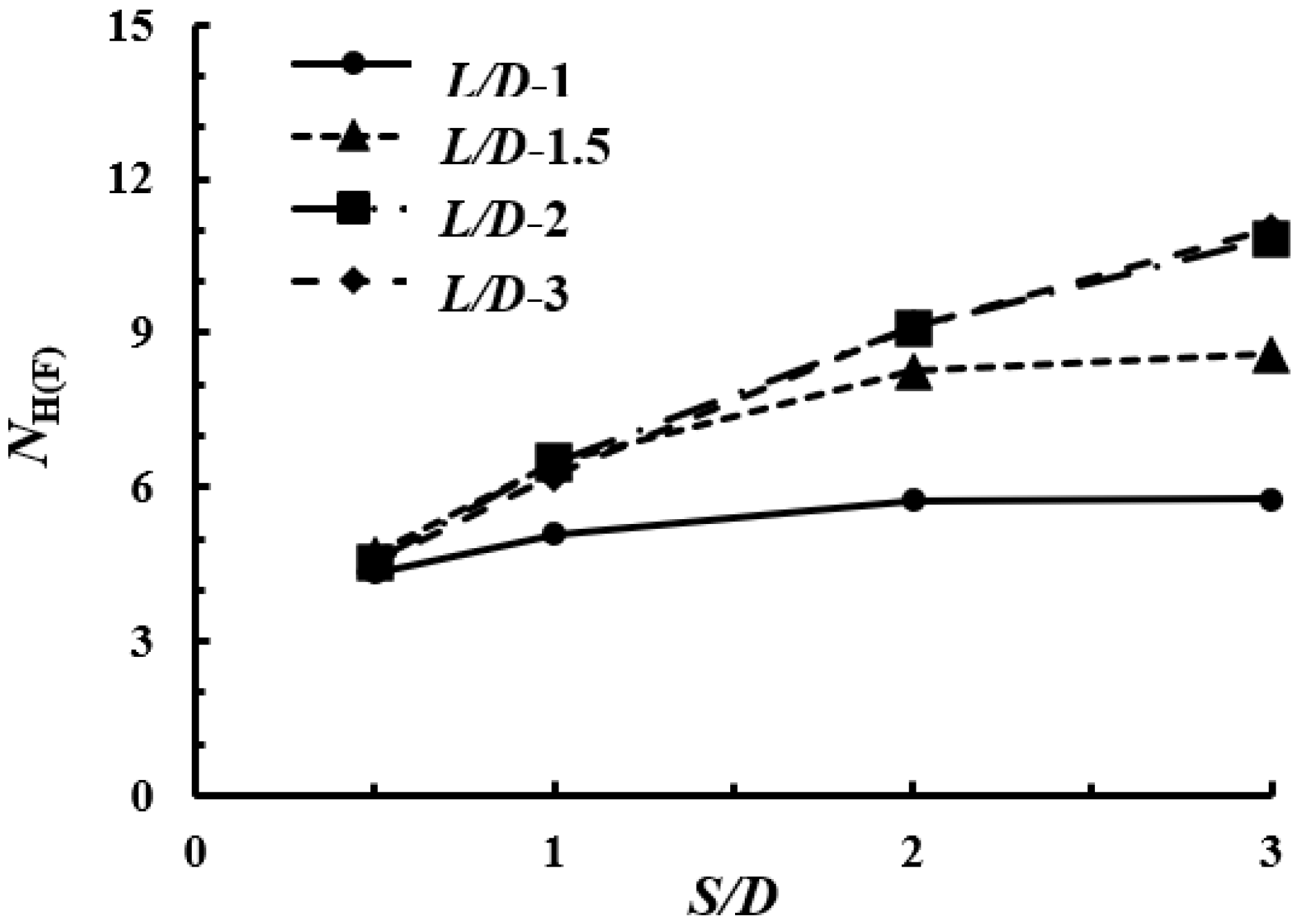
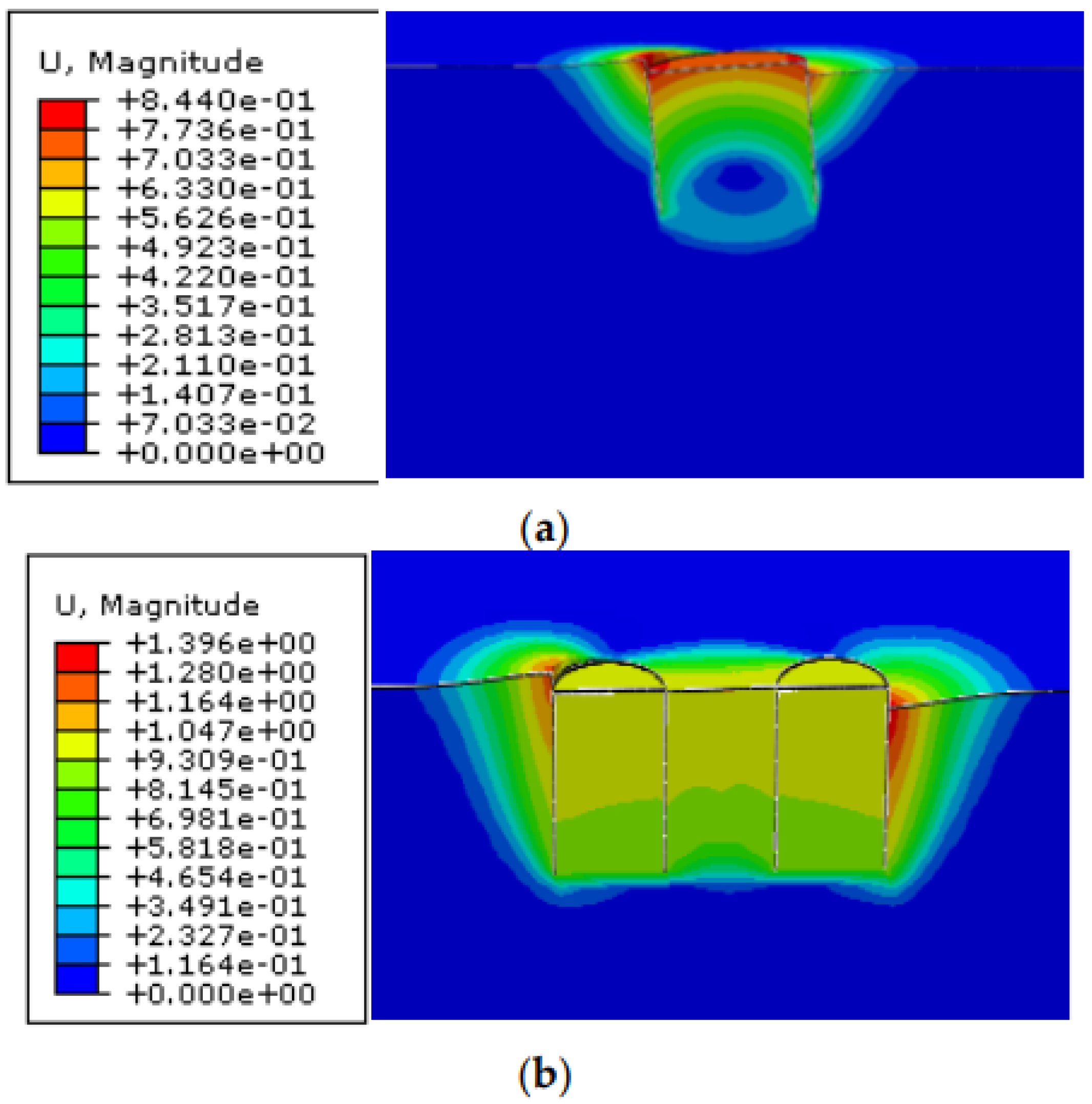
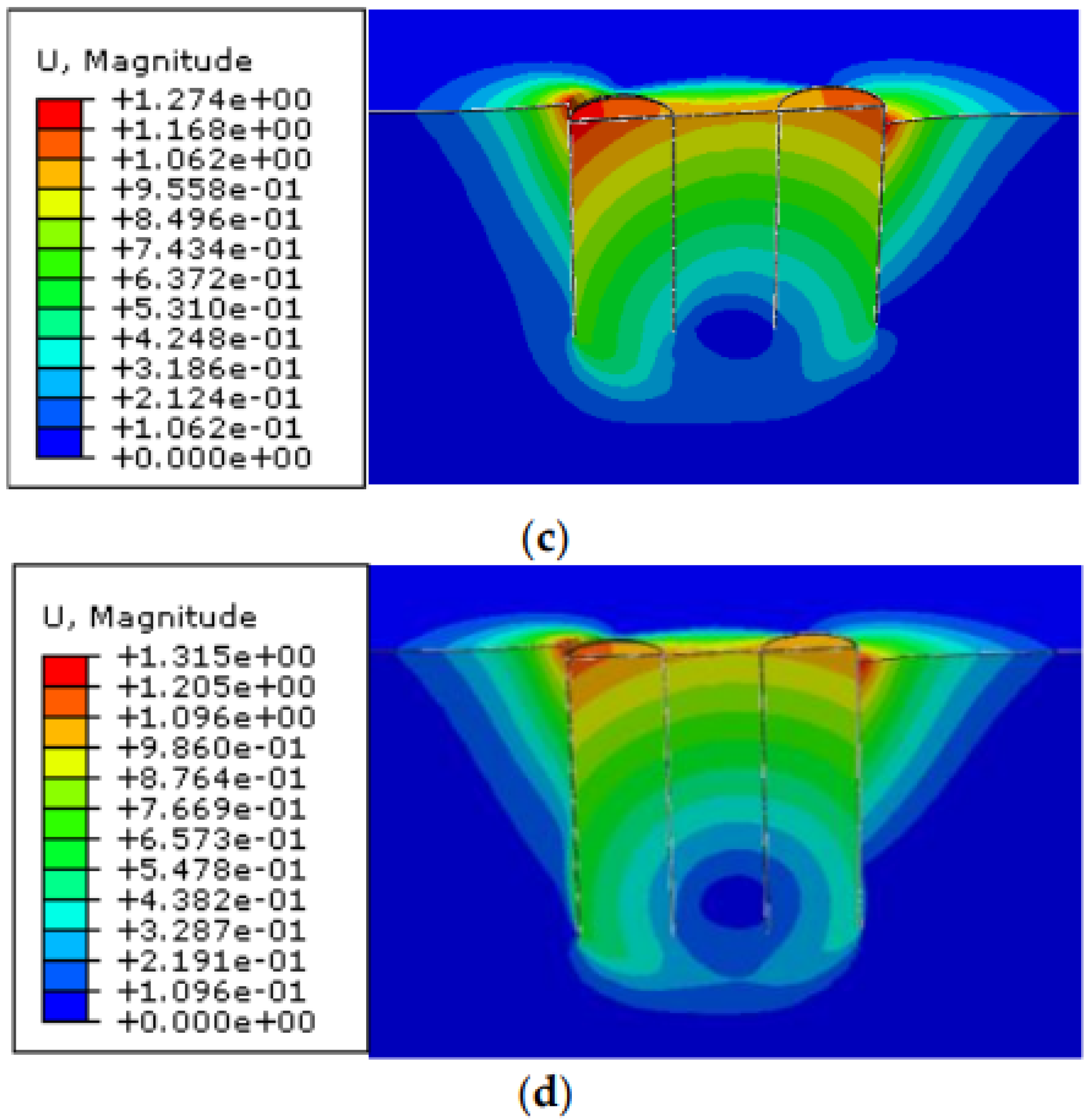
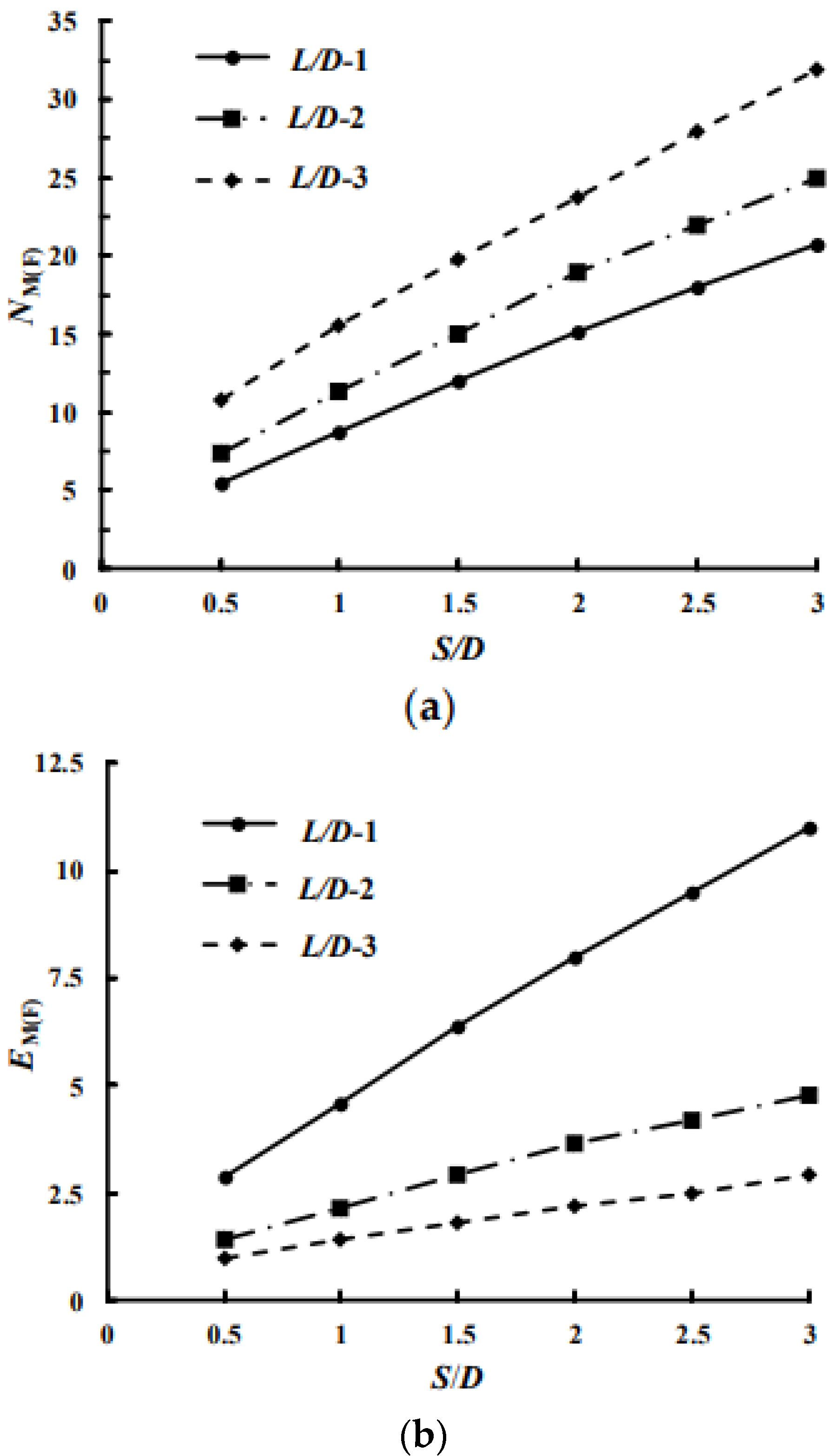
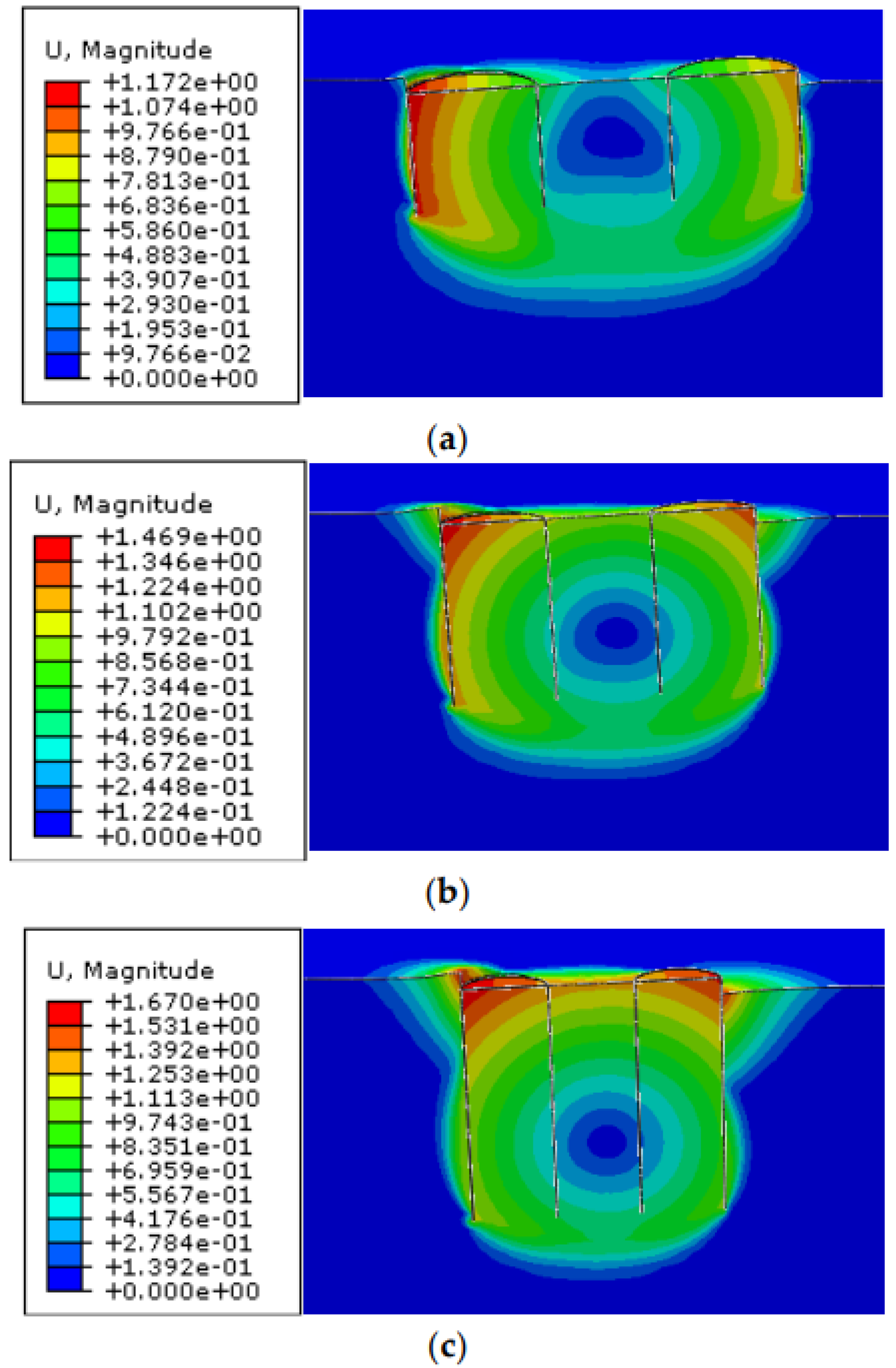
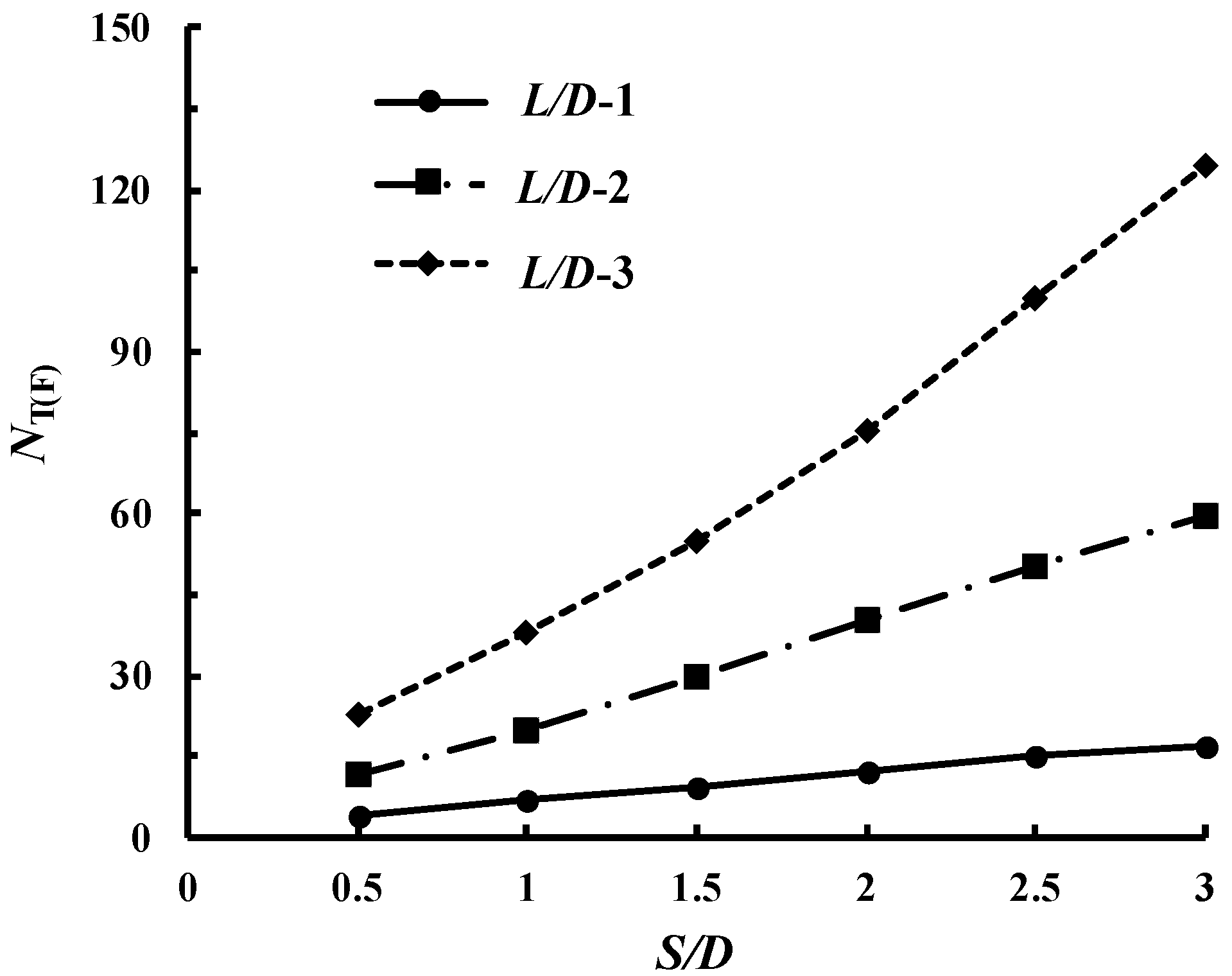


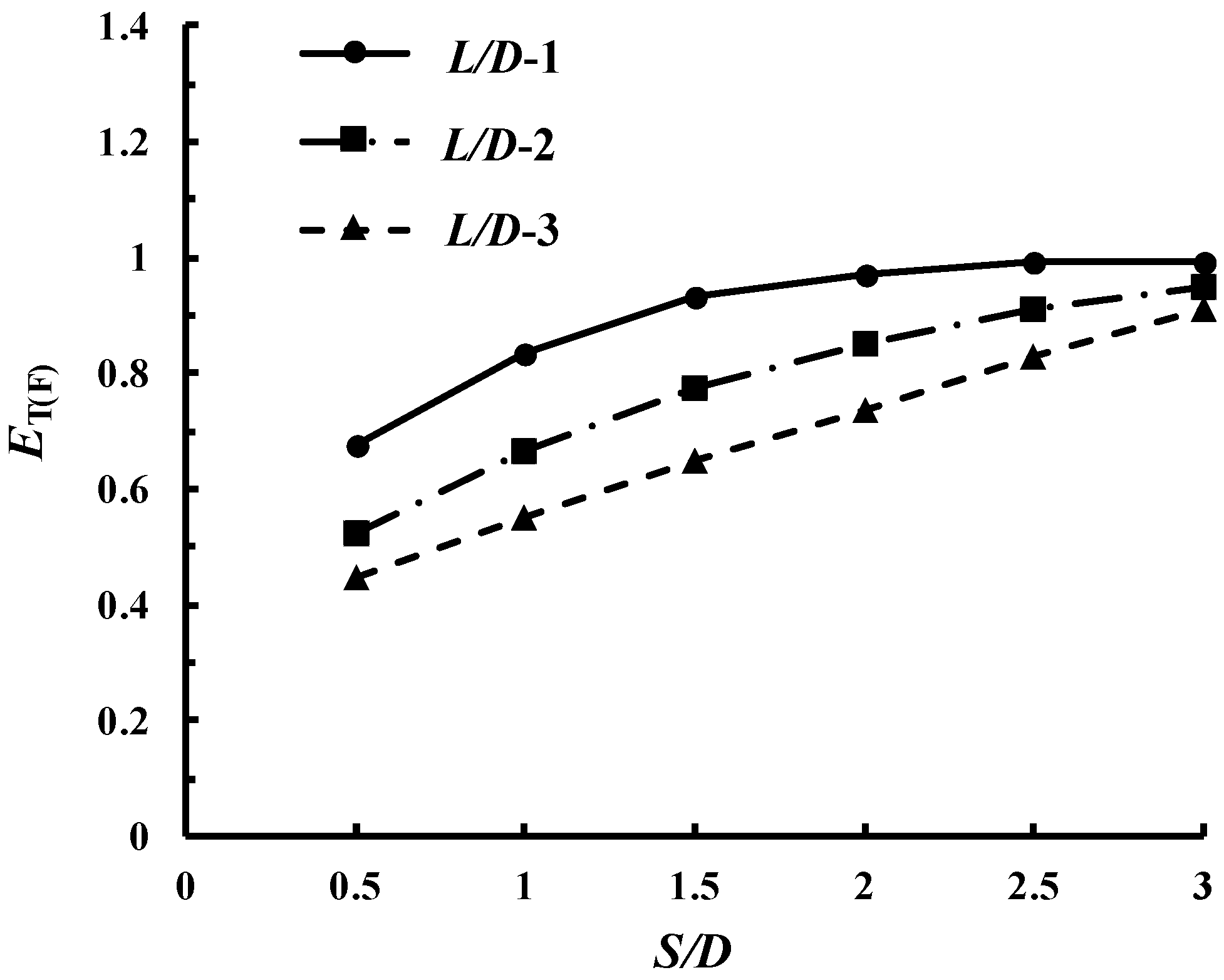
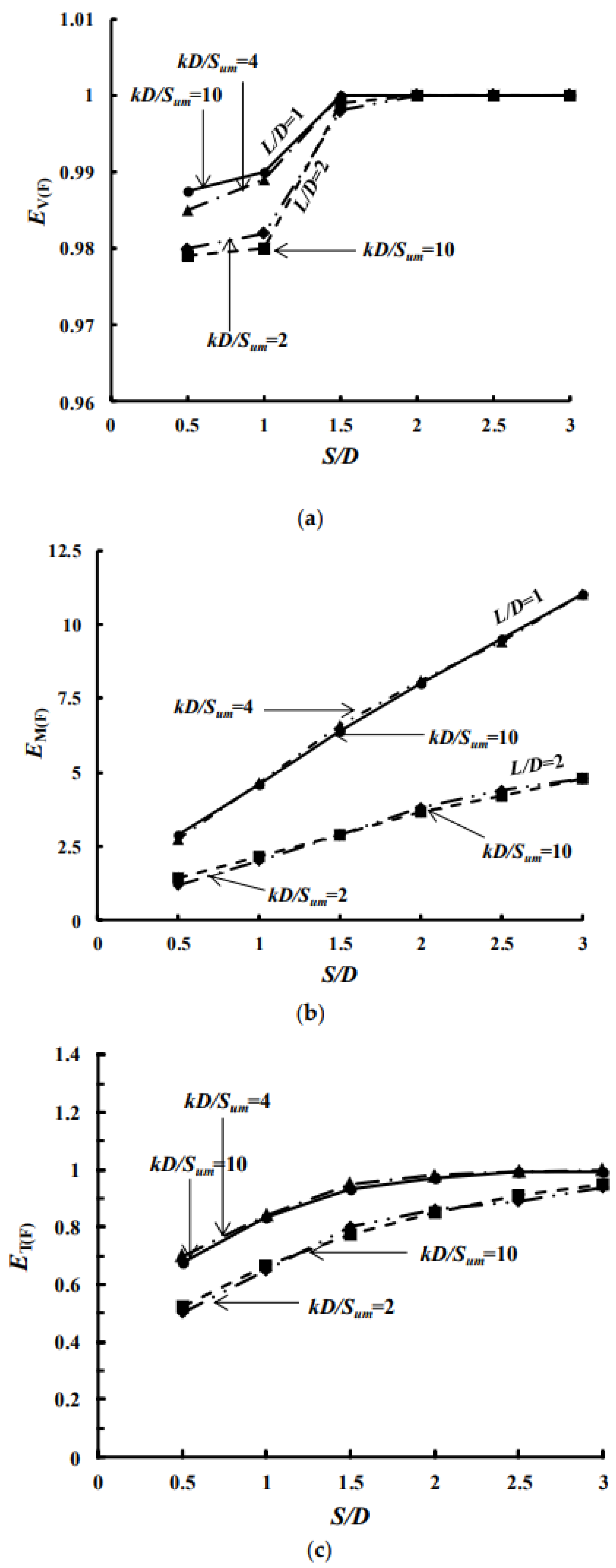



| Vertical | Horizontal | Moment | Torque | |
|---|---|---|---|---|
| Load at RP | V | H | M | T |
| Displacement at RP | V | h | ||
| Carrying capacity | Vult | Hult | Mult | Tult |
| Dimensionless load | NV = Vult/(ASuo) | NH = Hult/(ASuo) | NM = Mult/(ADSuo) | NT = Tult/(ADSuo) |
| Group efficiency | EV = NV(F)/NV(S) | EH = NH(F)/NH(S) | EM = NM(F)/NM(S) | ET = NT(F)/NH(S) |
| L/D | S/D | K (kPa/m) | Sum (kPa) | kD/Sum |
|---|---|---|---|---|
| 1 | 0.5–3 | 1.25 | 3.125 | 4 |
| 2 | 0.5–3 | 1.25 | 6.25 | 2 |
Publisher’s Note: MDPI stays neutral with regard to jurisdictional claims in published maps and institutional affiliations. |
© 2022 by the authors. Licensee MDPI, Basel, Switzerland. This article is an open access article distributed under the terms and conditions of the Creative Commons Attribution (CC BY) license (https://creativecommons.org/licenses/by/4.0/).
Share and Cite
Qi, Z.; Wei, T.; Wang, C.; Wang, F.; Wang, Y.; Wang, J.; Li, J. Numerical Study on Pile Group Effect and Carrying Capacity of Four-Barreled Suction Pile Foundation under V-H-M Combined Loading Conditions. Processes 2022, 10, 2459. https://doi.org/10.3390/pr10112459
Qi Z, Wei T, Wang C, Wang F, Wang Y, Wang J, Li J. Numerical Study on Pile Group Effect and Carrying Capacity of Four-Barreled Suction Pile Foundation under V-H-M Combined Loading Conditions. Processes. 2022; 10(11):2459. https://doi.org/10.3390/pr10112459
Chicago/Turabian StyleQi, Zhen, Tongzhong Wei, Changtao Wang, Fengyun Wang, Yin Wang, Jianghong Wang, and Juan Li. 2022. "Numerical Study on Pile Group Effect and Carrying Capacity of Four-Barreled Suction Pile Foundation under V-H-M Combined Loading Conditions" Processes 10, no. 11: 2459. https://doi.org/10.3390/pr10112459







